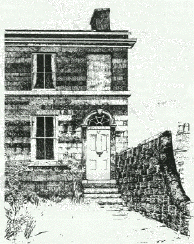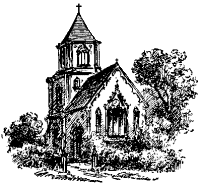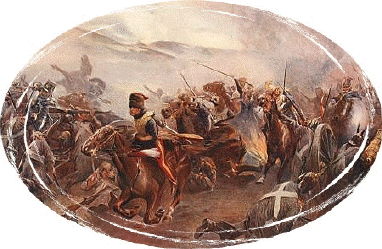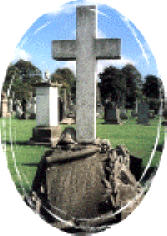 |
 |
 |
Battles
andBeatles
Woolton
Village
Just a
three wood across Menlove Avenue is Woolton Village which is on the surface a
pretty suburb of Liverpool but beneath the façade is desperately fighting to
retain the vestiges of village life in the face of an ever-encroaching and
all-encompassing "improved way of life" which means in effect more
traffic and more housing estates ---just two factors which have sounded the
death knell of suburbia all over England.
The history of Woolton dates from the Iron Age and is named after a Seventh
century farmer called Wulfa. His homestead was his "tun" and
Wulfra's tun translates quite easily into Woolton. Quarry Street is the
site of a vast excavation of sandstone used for the Anglican Cathedral and
across the road are the cottages of the workers built of the same stone.
The beauty of the village is mainly due to the use of local stone for its houses
great and small ranging from the Archbishops House to Quarry St itself.
Prior to the 1800's, the village was  extremely
tiny and retained fields and woods all around its centre. It was after
only 1800 that building expanded dramatically and in a theme that is familiar
around Liverpool the finest buildings were of local stone and a tribute to the
Victorian architects and builders. There was once a village
duck-pond which is now a car-park and could have been the template for a Joni
Mitchell anthem and there's a 1927 cinema which is fighting to stay alive- but
get up early enough before the cars are on the move and with a little
imagination you can still see how the village used to be.
extremely
tiny and retained fields and woods all around its centre. It was after
only 1800 that building expanded dramatically and in a theme that is familiar
around Liverpool the finest buildings were of local stone and a tribute to the
Victorian architects and builders. There was once a village
duck-pond which is now a car-park and could have been the template for a Joni
Mitchell anthem and there's a 1927 cinema which is fighting to stay alive- but
get up early enough before the cars are on the move and with a little
imagination you can still see how the village used to be.
Half-way up Church Road, St. Peter's Church benevolently overlooks the village and
is one of the few churches these days that can boast an overflow of parishioners
each Sunday. Throughout much of the remainder of the week the pretty but
innocuous church is an unexpected place of pilgrimage for music fans from all
over the world- with the great majority travelling from Japan and America.
Traditionally, pilgrims of all denominations have trekked to Holy places around
the globe in order to identify in some small way with some miraculous happening
or saintly event, some magnificent building or even a Holy Stone from the
heavens. St. Peter's Church is unique in that has become a Mecca
{ which is
in itself a contradiction in terms } for fans of the Beatles ---- whether any of
them see any irony in a pilgrimage to a Holy place for purely secular reasons is
open to question.
see any irony in a pilgrimage to a Holy place for purely secular reasons is
open to question.
For Beatles fans this is the legendary meeting place of
John Lennon and Paul McCartney, the place where it all began in the long-ago
summer of 1957 ---as momentous for
its adherents as Stanley's handshake with Livingstone, Napoleon's encounter with
Josephine or Sherpa Tensing's meeting with Hillary.
Rightly or wrongly, the modest Church of St. Peters in a tiny suburb of
Liverpool has become a shrine. It has joined the select company of
must-see sacred places throughout the land, on a par with St. Pauls Cathedral,
Canterbury and York ---there are many who would say for all the wrong
reasons. But with laudable Northern pragmatism, the
Church itself basks in the reflected glory of the worship of the two
"latter-day saints" John and Paul, and welcomes churchgoers whatever
their creed and whatever their reasons. Nevertheless, tourists outnumber
parishioners heavily and John Lennon's infamous "more famous
than Jesus
Christ" could be argued to be true in this place at least.
Visitors are shown the stage where the Quarrymen first played and where they
took to the field in the village fête but for most fans the headstone chiselled
with the name of Eleanor Rigby is the highlight of any visit. This is the
legendary site of Paul's inspiration for the hymn to down-trodden people
everywhere and fans stand with bowed heads and in awed silence as they come to
one of Christendom's most hallowed places.
Bermondsey showman, Tommy Steele, was so enamoured of the Eleanor Rigby
legend
that he went forthwith and created with his own hands a statue in honour of the
poor woman which is sited in the city centre and all for a commission of
half-a-sixpence. The statue is quite unusual
not just as the only tribute to a bag-lady in existence but there are a number
of objects within the bronze which are significant ---the other half of the half-a-sixpence recalls
Tommy's own successful musical of the same name, there's a copy of the iconic Liverpool
Echo newspaper, a 4-leaf clover, a football sock, a page of the Bible, the Beano
and Dandy, a football boot and four sonnets. A plaque behind the statue
dedicates the work to "All the lonely people".
There's also a solitary sparrow which is one of the very few left of once
millions. The mystery of the disappearing sparrow population is too
complex to be discussed here but is an enigma worthy of note.
The grave of arguably the finest Liverpool manager ever, in terms of
achievements, Bob Paisley, can be found in St Peters and so is an Unknown Soldier of the
First World War but there is one headstone which is rarely visited, standing in
the far corner of the churchyard. It is a family grave and the stone
simply lists the death of William Sewell on the 8th January 1910, no more and no
less. There are no fancy swords or marble allegories but it is the last
resting place of just a handful of Liverpool men who took place in one of the
momentous and disastrous cavalry charges in history.
===================================
The Charge of The Light
Brigade
On the 25th October,
1854, the harbour at Balaclava on the Crimean Peninsula was attacked at dawn by
a force of over 3,000 Russian cavalry -- if the attack had been succes sful it
would have been a major setback for the Allied forces. Five regiments of
British Heavy Cavalry deployed to stand in their way. While the stage was
set for a major cavalry battle four squadrons of Russian cavalry wheeled away
and headed directly towards the harbour and the British troops.
There then took place one of the many fabled engagements of the British
army which echo down the years and become more legendary with each
telling.
sful it
would have been a major setback for the Allied forces. Five regiments of
British Heavy Cavalry deployed to stand in their way. While the stage was
set for a major cavalry battle four squadrons of Russian cavalry wheeled away
and headed directly towards the harbour and the British troops.
There then took place one of the many fabled engagements of the British
army which echo down the years and become more legendary with each
telling.
The kilted infantry of the 93rd
Sutherland Highlanders led by Sir Colin Campbell hurried to block their path
with numbers so few that they were forced to deploy in a narrow line, not more
than three men deep. Not one to mince words, Campbell exhorted his
men while they stood waiting for the onslaught, with the immortal words;
" Men, remember there is no retreat from
here. You must die where you stand".
And stand they did, stopping the Russian cavalry in its tracks and
entering the Military Hall of Fame by so doing.
The Highlanders have
forever afterwards gone down in history as ;
The Thin Red Line.
The chances of two legendary military engagements taking place on the same day
must be slim but it could be argued that the example set by the Sutherland
Highlanders inspired a lust for glory by others to the point of
foolhardiness. The British Heavy Cavalry led by Sir James Scarlett were
certainly inspired when they took the shock of the main Russian cavalry attack
and ploughing through their lines broke them until they retreated in disarray
back to their guns on the hillside.
The Light Cavalry to date had not yet
seen action and "the finest cavalry brigade that ever
left the shores of England" was standing by impatiently, thirsting
for some part in the battle. The orders sent down by Lord Raglan as the
Light Brigade stood waiting are still a matter of conjecture but there is little
doubt that they were influenced a great deal by Captain Nolan's urgings towards
a confused Lord Lucan to send in the "Lights" to attack the retreating
Russian cavalry. Whatever the truth of the matter, Lord Lucan finally
passed on the order to his brother-in-law, Lord Cardigan to attack the 12
Russian guns just one mile away at the end of the valley. Cardigan's reply
was courteous and to the point ;
"Certainly,
Sir, but allow me to point out to you that the Russians have a battery in the
valley to our front and batteries and riflemen on each side".
Lucan pointed out that the orders were there to be obeyed and all the elements
were in place for another legend to be made that day. This time the legend
was one of glorious defeat as the Light Brigade trotted down the valley on the
first steps to annihilation. The French General Bosquet watching from the
heights remarked in wonderment ;
"It is magnificent but it is not war. It is
madness".
Travelling faster and faster as they neared their objective the
cavalry charged as it reached the Russian guns and was met with a stunning
cannonade which all but destroyed the front-line. The momentum of
the charge carried the remainder of the horsemen into the guns, where the
Russian gunners were cut down and their guns spiked and for a short period of
time the British held the field. In many ways, the attack was similar to
the fatal charge of the Union and Household Brigades at Waterloo and just as at
Waterloo, the British cavalry found themselves stranded and surrounded by an
enemy which had quickly  regrouped. There was no choice but to retreat and
the survivors frantically trying to get back to their lines were fired on from
three sides as they raced away from the ruined Russian battery. Out of an
initial 600 who charged down the valley that day a mere 195 answered the
roll-call and William Sewell was one of them.
regrouped. There was no choice but to retreat and
the survivors frantically trying to get back to their lines were fired on from
three sides as they raced away from the ruined Russian battery. Out of an
initial 600 who charged down the valley that day a mere 195 answered the
roll-call and William Sewell was one of them.
William Sewell
Strictly speaking, Sewell was not a true Liverpudlian having been born in Surrey
in 1832 but he spent most of his life in Woolton so we can justifiably claim him
as one of our own. He was Private Sewell when the Charge took place and he
did not come away unscathed ----his horse was killed under him and he was
severely wounded in the head. He mounted an enemy horse to return to his
lines and on his return to England was fitted with a metal plate over his wound
which remained in place for the rest of his days. He was presented to
Queen Victoria at Brompton Barracks in 1855 and received medals for Crimea,
Balaclava, Sebastopol and the Turkish medal.
The remainder of his days were spent in Liverpool where he was coachman for the
Earl family and in best 'upstairs, downstairs' fashion he married Mary, their
cook. They moved into a house on Woolton Hill but in the days when infant
mortality was common their two children died at ages 3 and 5 years old ---- it's
difficult to imagine just how traumatic those events were at this distance in
time. The headstones of the Victorian era are littered with similar
tragedies and usually state the facts baldly but rarely detail the harrowing
events or the sadness behind each death.
Mary died in 1907 and William died just 3 years later at no.18 Rose Lane,
Mossley Hill. His uniform can be seen in the National Army Museum.
There is a story that William Sewell was the inspiration for the 1936 film
Charge of The Light Brigade starring Errol Flynn and David Niven ---it seems
that the director was fascinated by the tale but like so many others he neglected to
visit the headstone tucked away in St. Peters churchyard.
Edward Sea ger
ger
Lt General Edward
Seager is one of only a handful of Liverpool men who took part in the
charge and he is the only one who had any rank above Private, riding with the
8th Hussars on the fateful day.
In the days when England retained a strict
class system it is significant that Seager as an officer is the only one who was
deemed worthy of a monument. His tomb stands on the left-hand side of the
main drive of Smithdown Rd { Toxteth} cemetery and ís a worthy but
unostentatious memorial to the man and although it is there for all to see there
are very few people ever notice the significance of the
monument.
There is
a strange phenomena about the tomb in that there are a number of quotations
chiselled into the monument which are fairly illegible until the sun shines upon
them and they are instantly as clear as if they had been carved yesterday.
On the reverse side is the inscription " Into the Valley
of the Shadow of Death Rode the 600"
and at the side are a helmet and sword with several more inscriptions at the
front.
Edward Hindley
Literally a stone's throw across the road, with the Woodcroft pub on the corner
is the erstwhile home of Private Edward Hindley at No.1 Woodcroft road.
Built around 1875, the houses today are a little run-down but still retain that
sturdiness common to most Victorian buildings ---when Edward Hindley lived there
they would have been sought -after working class dwellings. Prior to his
moving to Woodcroft, Hindley had lived in no 17 Granby Street.
Despite clusters of medals and a distinguished career when Hindley died in
1911he was buried in an unmarked grave { C of E no h789 }.
James Glanister
Although not strictly speaking a Liverpudlian, having been born in
Northamptonshire, James Glanister enlisted in Liverpool as a Private in the 5th
Dragoons. At Balaclava, he reached the Russian guns and broke his sword
upon the helmet of a Russian soldier. A Cossack then fired his pistol at
Glanister, shattering his jaw. He was assisted back to the safety of the
British lines by a Private Martin and later invalided out of the army later
settling down in West Derby where he died in 1901 at his home in No 3 Apple
Terrace. Buried in West Derby cemetery, his grave number is C of E,
section 5, grave no. 193.
Robert Martin
The bullet that hit Glanister
narrowly missed Private Martin who despite his own arm being shattered helped
Glanister back to the lines. But Martin was struck by another bullet and
was lucky to escape with his life. He did lose his arm which was amputated
 at the Scutari hospital where Florence Nightingale plied her trade so
well.
at the Scutari hospital where Florence Nightingale plied her trade so
well.
On his return home with a cluster of medals, the Liverpool M.P. Mr
Horsefall helped him to gain employment at Hampton Court Palace where he also
was received by Queen Victoria and Prince Albert. On his retirement he
went to live in New Ferry on the Wirral and in his final days was taken to the
Liverpool Royal Infirmary where he died in 1900. He was buried in
Bebington cemetery ---also in a numbered grave.
There were several
others who lost their lives at Balaclava but they are fast fading back into the
obscurity they lived in until they took their places in the historic charge.
Botanic Park was once one of the finest gardens in the country and at the Picton
Road entrance there stood two Russian cannon from the Crimea. It is an
irony that having been taken away during the Second World War they were melted
down to create armament and that somewhere over Europe in 1945, metal from the
1856 conflict would still be lethally dangerous.
A small commentary on the Victorian era is that of the few graves described
above only Edward Seager has a headstone worthy of note and he was the only one
who was an officer.
